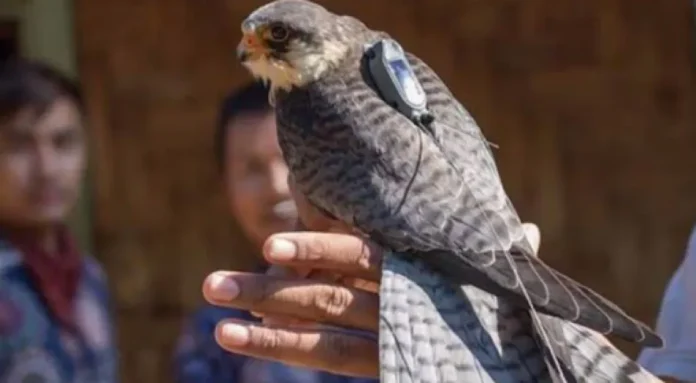IMPHAL, April 15: A male Amur Falcon, Chiuluan 2, fitted with a satellite transmitter in Manipur’s Tamenglong district in November 2024, has begun its remarkable northward return journey after spending 114 days in Southern Africa. According to Dr. Suresh Kumar, a senior scientist at the Wildlife Institute of India (WII), Dehradun, who has been tracking the bird’s movements via satellite, Chiuluan 2 started its return flight from Botswana on April 8.
Dr. Kumar confirmed that the falcon had already crossed Zimbabwe and Tanzania and was currently near the Kenya-Somalia border. The bird had spent 46 days in the Central Kalahari Reserve in Botswana before commencing its long journey back. The scientist also noted that Chiuluan 2 was expected to begin its oceanic crossing in the next ten days.
Chiuluan 2 was released after being fitted with the satellite transmitter on November 8, 2024, in Tamenglong district. The falcon had embarked on a lengthy migration, covering over 14,500 km from Manipur to its wintering grounds in Southern Africa. The bird reached South Africa on December 20, before heading to Botswana.
Amur Falcons, roughly the size of a pigeon, are known for undertaking one of the longest migratory journeys in the avian world. They migrate annually from the cold climates of Siberia and northern China to Southern Africa, returning via the same route around April-May to their breeding grounds near the Amur River. Chiuluan 2, named after a roosting village in Tamenglong, had flown across Bangladesh, Odisha, Maharashtra, and the Arabian Sea before reaching East Africa during its southbound migration last year.
Another Amur Falcon, a female named Guangram, was also radio-tagged in October 2024 and was being tracked alongside Chiuluan 2. However, Guangram stopped transmitting satellite data near Kenya in December, as reported by Kh Hitler Singh, Tamenglong Divisional Forest Officer. Guangram had begun her migration later and traveled separately from Chiuluan 2.
While Amur Falcons use Tamenglong and parts of Northeast India as stopover sites during their southbound migration in October, they typically do not return to the area on their northward journey. According to Singh, these falcons are expected back in October after completing their breeding season at the Amur River region, which spans from May to October.
Locally known as Akhuaipuina, Amur Falcons are a cherished presence in the Northeast during their annual passage. They stay for around 45 days to feed and prepare for their arduous transcontinental journey. The ongoing satellite tagging project is part of an effort to better understand the migratory behavior of these birds and enhance conservation efforts for this globally migrating species.

